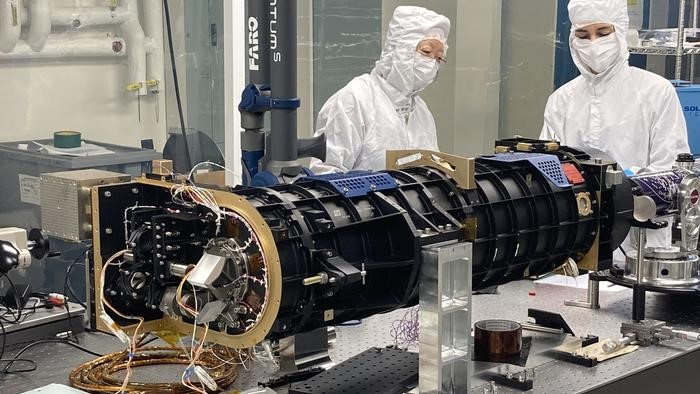New NASA coronagraph will measure temperature, speed of solar wind from ISS
"CODEX's observations will contribute to our understanding of the region that space weather travels through, helping improve predictions."

On Earth, we have weather because we have an atmosphere. Electromagnetic radiation from the sun heats up molecules and gases in the atmosphere, which causes the dynamic weather systems that cover the globe on a daily basis.
Perhaps counterintuitively, there is also weather in space, which is generated by the sun's activity — for example, the solar wind, the stream of charged particles flowing continuously from our star.
We're about to learn more about the solar wind, thanks to NASA's newly launched Coronal Diagnostic Experiment (CODEX). CODEX is a solar coronagraph that arrived at the International Space Station (ISS) on Tuesday (Nov. 5) aboard a SpaceX Dragon cargo capsule. A coronagraph is an instrument that blocks out harsh light from the sun, to better expose regions around the sun — such as its outer atmosphere, known as the corona — for direct observation.
“Just like understanding hurricanes, you want to understand the atmosphere the storm is flowing through," Jeffrey Newmark, principal investigator for the instrument and a scientist at NASA's Goddard Space Flight Center in Maryland, said in a press release. "CODEX's observations will contribute to our understanding of the region that space weather travels through, helping improve predictions."
Related: Space weather: What is it and how is it predicted?
This new coronagraph, which will be affixed to the exterior of the ISS, is capable of providing researchers with details on the temperature and speed of the solar wind via special filters. A typical solar coronagraph can observe the density of plasma — extremely hot, electrically charged matter — flowing away from the sun, but by observing the temperature and speed of the solar wind in addition to the density of plasma the wind interacts with, CODEX will give astronomers a more well-rounded picture of what conditions are contributing to the solar wind itself.
You're going to get to see the evolution of structures in the solar wind, from when they form from the sun's corona until they flow outwards and become the solar wind," Nicholeen Viall, co-investigator of CODEX and heliophysicist at NASA Goddard, said in the same release.
Get the Space.com Newsletter
Breaking space news, the latest updates on rocket launches, skywatching events and more!
CODEX should help scientists understand how the solar wind manages to reach scorching temperatures of around 1.8 million degrees Fahrenheit (1 million degrees Celsius), which is 175 times hotter than the sun's surface, and speeds of almost 1 million mph (1.6 million kph).
Being located in space, CODEX will avoid the brightness of Earth's atmosphere in its observations. It will also start operating at an opportune moment, as the sun has reached its solar maximum phase, a period of high activity during its 11-year cycle.
"The types of solar wind that we get during solar maximum are different than some of the types of wind we get during solar minimum," Viall said. "There are different coronal structures during this time that lead to different types of solar wind."
CODEX will be looking for two distinct types of solar wind. The first is wind that travels outward from the star itself, and the second is wind that is ejected when closed magnetic field lines around the sun snap open, sending charged particles that were trapped along these magnetic field lines out into space.
Join our Space Forums to keep talking space on the latest missions, night sky and more! And if you have a news tip, correction or comment, let us know at: community@space.com.

Conor Feehly is a New Zealand-based science writer. He has earned a master's in science communication from the University of Otago, Dunedin. His writing has appeared in Cosmos Magazine, Discover Magazine and ScienceAlert. His writing largely covers topics relating to neuroscience and psychology, although he also enjoys writing about a number of scientific subjects ranging from astrophysics to archaeology.









